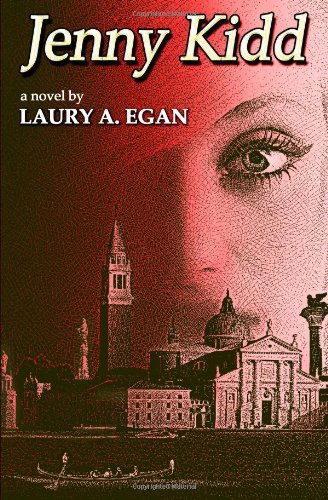 Jenny Kidd
Jenny Kidd
by Laury A. Egan
Vagabondage Press. 206 pages, $14.95
A YOUNG American artist, Jenny Kidd, has left a dull job and her overbearing parents behind to come to Venice. In New York, she feels trapped between her parents’ expectations, her need to make a living, and her desire to paint and teach or illustrate. In Venice, hoping that her paintings might provide a livelihood, she also explores her curiosity about lesbianism and her own sexuality. Since coming out requires desire plus opportunity, the story opens with both. While at the Peggy Guggenheim Collection, standing captivated before Kandinsky’s painting White Cross, she meets a British woman, Randi Carroll, who invites her to a masquerade party at Palazzo Barbon, and thus begins a chilling adventure.
At the party, Jenny dances with several people who are wearing masks. Often she can’t tell if her dance partner is male or female. Despite her curiosity and the amount of alcohol she has consumed, she’s somewhat surprised by her powerful reaction to holding a female in an embrace while dancing. At the end of the night, she staggers home and into bed. The next morning she discovers that her apartment has been burglarized. She immediately suspects Randi, the one person who knew she wouldn’t be home that night. The first thing she has to do is make a report to the police and then talk to her parents to get enough money to remain abroad. Her father insists that she return home, but Jenny convinces her mother to send more money. She stays in the city, captivated by the atmosphere, the art and architecture, and the old-world streets and waterways. She also meets an art dealer who likes her paintings and asks to see more.
The next evening, Jenny finds Caterina Barbon, who, along with her brother Sebastiano, had hosted the party. Jenny explains that her things were stolen. While she finds Caterina attractive, she’s more concerned with locating Randi. Later, Jenny is visited by the police and learns that a woman who was at the party has been murdered, her body found floating in a canal. Jenny is frightened by this, but by then she has started a portrait of Caterina Barbon and fallen under her spell, and a new passion overshadows everything else.
The beginning chapters of the book are filled with desire, seduction, and sexual obsession. While the story starts slowly due to the author’s careful and intricate construction of the plot elements, eventually the pace picks up. The plot becomes precise and at times dizzying in its twists and turns. Speaking for myself, once I had reached the half-way point in the book, I found it impossible to put it down.
Jenny has much to learn. She loves art but doesn’t know if she’s good enough; she’s attracted to women but doesn’t know if she’s lesbian. As she seeks answers, everything becomes much more sinister and compelling, and Jenny, along with the reader, is drawn into a dark, dangerous, and erotic world of insanity at the Barbon’s home. With Caterina and her brother, nothing is as it seems. Along with Jenny, we ask ourselves if small things are significant, as each minor incident—a mysteriously locked door, an intruder in the night—is rationalized or explained away. By the time Jenny realizes she is trapped and will be the next murder victim, her predicament seems hopeless.
This is Laury Egan’s first novel, though she’s published two books of poetry and a short story collection. She does not abandon the rich language displayed in her shorter works, including her vivid descriptions of the canals, bridges, cafes, and cuisine of Venice. Not only does her book offer a riveting story, but her sentences have a cadence that will carry you along.
____________________________________________________________
Martha Miller’s is the author of Retirement Plan: A Crime Story.






